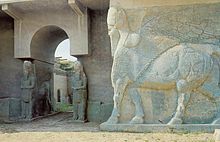
Back Kalach ALS Nimrud AN كالح Arabic كالح ARZ Nimrud Azerbaijani Нимруд Bashkir Німруд Byelorussian Нимруд Bulgarian Nimrud BS Nimrud Catalan
 A lamassu at the North West Palace of Ashurnasirpal II before destruction in 2015. | |
| Alternative name | Calah, Kalakh, Kalhu |
|---|---|
| Location | Numaniyah, Al-Hamdaniya, Nineveh Governorate, Iraq |
| Region | Mesopotamia |
| Coordinates | 36°05′53″N 43°19′44″E / 36.09806°N 43.32889°E |
| Type | Settlement |
| Area | 3.6 km2 (1.4 sq mi) |
Nimrud (/nɪmˈruːd/; Syriac: ܢܢܡܪܕ Arabic: النمرود) is an ancient Assyrian city (original Assyrian name Kalḫu, biblical name Calah) located in Iraq, 30 kilometres (20 mi) south of the city of Mosul, and 5 kilometres (3 mi) south of the village of Selamiyah (Arabic: السلامية), in the Nineveh Plains in Upper Mesopotamia. It was a major Assyrian city between approximately 1350 BC and 610 BC. The city is located in a strategic position 10 kilometres (6 mi) north of the point that the river Tigris meets its tributary the Great Zab.[1] The city covered an area of 360 hectares (890 acres).[2] The ruins of the city were found within one kilometre (1,100 yd) of the modern-day Assyrian village of Noomanea in Nineveh Governorate, Iraq.
The name Nimrud was recorded as the local name by Carsten Niebuhr in the mid-18th century.[3][note 1] In the mid 19th century, biblical archaeologists proposed the Assyrian name Kalḫu (the Biblical Calah), based on a description of the travels of Nimrod in Genesis 10.[note 2]
Archaeological excavations at the site began in 1845, and were conducted at intervals between then and 1879, and then from 1949 onwards. Many important pieces were discovered, with most being moved to museums in Iraq and abroad. In 2013, the UK's Arts and Humanities Research Council funded the "Nimrud Project", directed by Eleanor Robson, whose aims were to write the history of the city in ancient and modern times, to identify and record the dispersal history of artefacts from Nimrud,[4] distributed amongst at least 76 museums worldwide (including 36 in the United States and 13 in the United Kingdom).[5]
In 2015, the terrorist organization Islamic State announced its intention to destroy the site because of its "un-Islamic" Assyrian nature. In March 2015, the Iraqi government reported that Islamic State had used bulldozers to destroy excavated remains of the city. Several videos released by ISIL showed the work in progress. In November 2016, Iraqi forces retook the site, and later visitors also confirmed that around 90% of the excavated portion of city had been completely destroyed. The ruins of Nimrud have remained guarded by Iraqi forces ever since.[6] Reconstruction work is in progress.
- ^ Brill's Encyclopedia of Islam 1913-36, p.923
- ^ Mieroop, Marc van de (1997). The Ancient Mesopotamian City. Oxford: Oxford University Press. p. 95. ISBN 9780191588457.
- ^ Cite error: The named reference
Brillwas invoked but never defined (see the help page). - ^ The Nimrud Project at Oracc.org
- ^ The Nimrud Project at Oracc.org: Museums worldwide holding material from Nimrud; "Material from Nimrud has been dispersed into museum collections across the world. This page currently lists 76 museums holding Nimrud objects, with links to online information where available. The Nimrud Project welcomes additions and amendments to the list".
- ^ "Isis destroyed a 3,000-year-old city in minutes". The Independent. 2017-01-06. Archived from the original on 2022-06-21. Retrieved 2017-04-13.
Cite error: There are <ref group=note> tags on this page, but the references will not show without a {{reflist|group=note}} template (see the help page).

